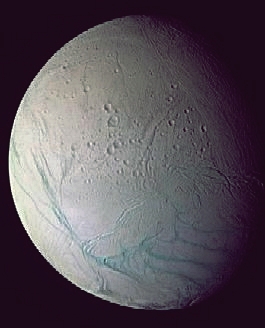
 Tectonics at Enceladus. With a radius of about 155 mi (250 km), Enceladus is a small of the main moons of Saturn, the ringed planet. It's the second nearest of them, on the other hand, to the planet. Like all Saturn's moons, Enceladus is an icy world. But, as most of Saturn's moons have highly cratered and tormented terrain, Enceladus' seems smoothed, snow-covered. The fact is that there is a dust-icy cloud around Enceladus. It's still badly known whether such a cloud is provided from particles of the E ring, a vast, outer component of the Saturn's ring system, or whether the interaction is the reverse, with some sort of activity at Enceladus creating the cloud and the E ring. Should Enceladus really have this kind of atmosphere, it would need in any case a source of replenishment, as the weak gravity of the moon is not able to retain it. Enceladus, like all the Saturnian world, is currently the object of the collaborative NASA/European Space Agency (ESA)/Italian Space Agency mission Cassini. Cassini, once released an ESA piggy-backed probe to Titan, Saturn's major moon, in January 2005, is now performing an extensive study of Saturn and its moons. During a late imaging passage at Enceladus by July 2005, Cassini have further seen that the south pole of the moon is framed with a system of tectonic faults, which is isolating the south polar terrains from the older surrounding ones, at about 60° south latitude. It might that such a fault system, as well seen here, originate at a variation of the moon's rotation -likely due to tidal interactions with the planet and other moons. Such a tectonics might be then at the origin of an active Enceladus, with cryo-volcanism, geysers, or gases. picture NASA/JPL/Space Science Institute
Website Manager: G. Guichard, site 'Amateur Astronomy,' http://stars5.6te.net. Page Editor: G. Guichard. last edited: 12/28/2010. contact us at ggwebsites@outlook.com
Tectonics at Enceladus. With a radius of about 155 mi (250 km), Enceladus is a small of the main moons of Saturn, the ringed planet. It's the second nearest of them, on the other hand, to the planet. Like all Saturn's moons, Enceladus is an icy world. But, as most of Saturn's moons have highly cratered and tormented terrain, Enceladus' seems smoothed, snow-covered. The fact is that there is a dust-icy cloud around Enceladus. It's still badly known whether such a cloud is provided from particles of the E ring, a vast, outer component of the Saturn's ring system, or whether the interaction is the reverse, with some sort of activity at Enceladus creating the cloud and the E ring. Should Enceladus really have this kind of atmosphere, it would need in any case a source of replenishment, as the weak gravity of the moon is not able to retain it. Enceladus, like all the Saturnian world, is currently the object of the collaborative NASA/European Space Agency (ESA)/Italian Space Agency mission Cassini. Cassini, once released an ESA piggy-backed probe to Titan, Saturn's major moon, in January 2005, is now performing an extensive study of Saturn and its moons. During a late imaging passage at Enceladus by July 2005, Cassini have further seen that the south pole of the moon is framed with a system of tectonic faults, which is isolating the south polar terrains from the older surrounding ones, at about 60° south latitude. It might that such a fault system, as well seen here, originate at a variation of the moon's rotation -likely due to tidal interactions with the planet and other moons. Such a tectonics might be then at the origin of an active Enceladus, with cryo-volcanism, geysers, or gases. picture NASA/JPL/Space Science Institute
Website Manager: G. Guichard, site 'Amateur Astronomy,' http://stars5.6te.net. Page Editor: G. Guichard. last edited: 12/28/2010. contact us at ggwebsites@outlook.com

